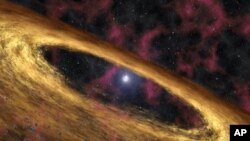A distant planet barely bigger than Earth has been discovered in our galaxy, but it might have been missed if not for the combined efforts of several observatories both on and around our home planet.
U.S. space agency astronomers say the hard-to-detect data gathered during multiple readings by the Kepler space telescope and two ground observatories revealed tiny clues they needed to make the improbable discovery of a so-called super-Earth planet that otherwise would have gone undetected.
NASA's orbiting Kepler probe initially detected the super-Earth - a distant rocky planet about the size of the Earth - in our Milky Way galaxy about 350 light years from our solar system. Overlapping readings taken by two ground-based telescopes at the Kitt Peak National Observatory in Arizona confirmed the discovery.
Discovering a relatively small, Earth-sized planet so far away is remarkable because usually only distant planets at least as big as our solar system’s monstrous gas-giant, Jupiter, can be detected - and Jupiter has nearly 320 times more mass than the Earth, with 120 times more surface area.
The newly-found alien world is relatively small at only 1.6 times the size of the Earth. It also streaks around its very bright star in just 2.8 days, and orbits from a scorchingly close distance of 6 million kilometers, making the bizarre super-Earth more difficult to track and identify.
The NASA astronomers say the task took 65 scientists 15 months and that the multiple precision measurements and other readings taken by Kepler and the Kitt Peak telescopes made such a sensitive planet detection possible.
In a related development, the California Institute of Technology, Caltech, on Friday announced the significant discovery of 18 Jupiter-sized planets. The huge alien worlds, or exoplanets, were detected in a decade-long survey of more than 300 expanding, aging stars.
Details of the separate NASA and Caltech discoveries will appear in reports published in an upcoming edition of Astrophysical Journal.
Astronomers search for distant planets by measuring a star's brightness. Planets passing between the star and the telescope will cause its instruments to register a slight dimming in the star's brightness.
The NASA scientists emphasize that just because a planet is categorized as a super-Earth does not mean it is Earth-like. They say the newly-found super-Earth is heavy and dense, with a mass no more than 10 times that of the Earth, and it has a surface temperature of 1,630 degrees Celsius, which is hot enough to melt iron.
In contrast to the strange exoplanet's brief 2.8-day year and scorching proximity to its star, the Earth is a comfortable 150 million kilometers away from the Sun, and takes a leisurely 365 days to make a complete solar orbit.











